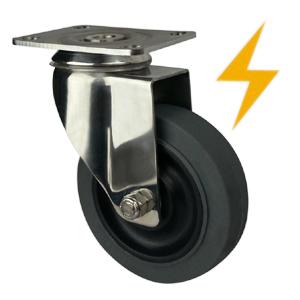Stainless Steel Caster

Description:
Name:stainless steel antistatic casters and wheelsMaterial:stainless steel bracket,TPR ESD wheel
Size: Ø75mm x 32mm ; Ø100mm x 32mm ; Ø125mm x 32mm
Load Weight:60kg-100kg
Bearing:Ball Bearing
| Caster No. | Wheel | Material | Bearing | Plate | Mount | Hole | Height | Loading |
| R59SP-3 | 75 x 32 | TPR | Ball Bearing | 94 x 69 | 73 x 48 | 6 x 13 | 111 | 60 kg |
| R59SP-4 | 100 x 32 | TPR | Ball Bearing | 94 x 69 | 73 x 48 | 6 x 13 | 137 | 80 kg |
| R59SP-5 | 125 x 32 | TPR | Ball Bearing | 94 x 69 | 73 x 48 | 6 x 13 | 163 | 100 kg |
Antistatic casters and wheels are designed to prevent the buildup and discharge of static electricity, making them essential in environments where electrostatic discharge (ESD) could cause damage to sensitive electronic equipment, ignite flammable materials, or create unsafe working conditions. These casters are widely used in industries such as electronics manufacturing, medical facilities, laboratories, and clean rooms.
This guide will explore the features, benefits, and common applications of antistatic casters and wheels, explaining why they are an important safety component in various specialized industries.
1. What Are Antistatic Casters and Wheels?
Antistatic casters and wheels are designed with materials that dissipate static electricity as they roll across the floor, preventing the buildup of electrostatic charges. Unlike traditional casters, which may generate static due to friction between the wheel and the floor, antistatic wheels either dissipate or conduct these charges safely into the ground.
Key materials used in antistatic wheels include:
Conductive rubber: Allows the safe dissipation of electrical charges through the wheel into the ground.
Carbon-filled compounds: Carbon is often added to rubber or polyurethane to enhance their ability to conduct and dissipate static electricity.
The frame or housing of these casters is often equipped with conductive components that ensure any static buildup is transferred away from the wheel and into the flooring or a designated grounding system.
2. Key Features and Benefits
Static Dissipation
The primary function of antistatic casters is their ability to safely dissipate static electricity. By preventing the buildup of electrostatic charges, they minimize the risk of sparks, which could ignite flammable materials or damage sensitive electronics. This is crucial in environments like electronics manufacturing, where static discharges can ruin components or disrupt equipment.
Durability and Load Capacity
Antistatic casters are designed for heavy-duty applications. They often feature materials such as rubber, polyurethane, or thermoplastic, which provide excellent strength, shock absorption, and durability. As a result, these casters can support significant loads while maintaining their antistatic properties.
Floor Protection
Many antistatic wheels are non-marking, which means they won’t damage or scuff sensitive flooring, such as epoxy, vinyl, or conductive tile floors that are common in cleanrooms and electronics facilities. The non-marking feature helps keep floors clean and undamaged, maintaining a professional and safe environment.
Smooth Mobility
Antistatic casters offer smooth and reliable rolling performance, which reduces the amount of force required to move equipment. This enhances operational efficiency and reduces the risk of injury, as employees can easily move heavy loads without straining.
3. Applications of Antistatic Casters and Wheels
Electronics Manufacturing
In electronics manufacturing plants, static electricity poses a serious risk to sensitive electronic components. Antistatic casters ensure that carts, trolleys, and equipment racks can be safely moved around the facility without generating static that could damage circuit boards, chips, and other components.
Cleanrooms
Cleanrooms require strict control of environmental contaminants, including static electricity. Antistatic casters help maintain the integrity of cleanroom conditions by preventing the buildup of static. They are commonly used on furniture, equipment, and supply carts in semiconductor, pharmaceutical, and biotech industries.
Medical Facilities
Medical equipment, especially in hospitals and diagnostic centers, often involves sensitive electronics such as MRI machines, patient monitors, and testing equipment. Antistatic casters help protect this equipment from electrostatic discharge, ensuring it operates without disruption.
Laboratories
In laboratory environments, antistatic casters are critical for preventing static discharges that could interfere with delicate instruments or spark flammable materials. They are used on lab benches, chemical storage carts, and test equipment.
Hazardous Environments
In environments where flammable gases or dust are present, such as chemical plants or paint shops, antistatic casters are essential for preventing sparks that could cause explosions or fires. By dissipating static charges, these casters help maintain a safer working environment.
Antistatic casters and wheels play a critical role in protecting equipment, materials, and workers from the dangers of static electricity. With applications ranging from electronics manufacturing to cleanrooms and hazardous environments, these casters provide an essential safety feature while ensuring smooth mobility, durability, and floor protection. Their ability to prevent electrostatic discharge makes them an indispensable component in industries where static buildup could result in costly damage or safety hazards.

 English
English Spanish
Spanish German
German Russian
Russian Arabic
Arabic Portuguese
Portuguese Italian
Italian French
French Hebrew
Hebrew Turkish
Turkish